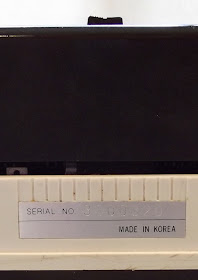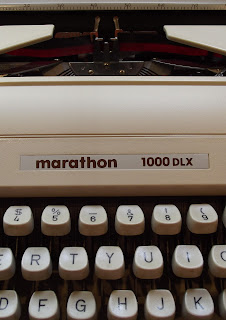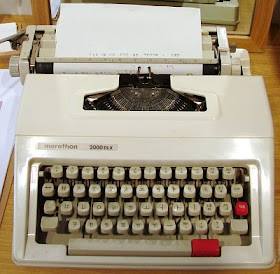Following on from buying the Reader’s Digest 1000, and having read up on Korean typewriters on Will’s site, I was able to obtain a Marathon 1000 DLX (deluxe), which is quite a nice typer.
The Dong-Ah company is headquartered in Dongtan-Myeon in Hwaseong City, just south of Seoul. It was founded as the Dong-Ah Corporation in 1975 and on December 11, 1989, the Dong-Ah Precision Industry Company was established.
Will’s page on Korean typewriters is at:
He begins by looking at the Silver-Seiko clone, the Clover, made by K-Mek Inc in 1978. This company began life in 1973 as Sae-Han Pacific Company and became K-Mek in mid-1977. It started making typewriters in April the following year. The company evolved into Kyungbang Machinery Co in 1989 then Growell Metal Inc.
Will says Silver-Seiko sold off its tooling for manual portables in 1978; the small portables and the larger portables such as the Marathon/Reader’s Digest models went to Korea while a mid-size portable went to Bulgaria (I am about to post on this machine, the Maritsa 22).
Will says the Reader’s Digest 1000 is derived from the Silver-Reed 500 series. He says the Royal Safari III, identical to the Marathon 1000 DLX, was made in Korea after Litton's deal with Silver-Seiko expired in the late 1970s.
“The much more common Royal Safari III (pictured above) … is essentially identical to the Reader's Digest 1000. Other examples of this machine can be found labelled with the name Marathon.”
Will also raises the question of a Chinese connection somewhere along the way, and I must say the Reader’s Digest 1000 has, to me, all the look and feel of Chinese typewriters. The Marathon, however, feels somewhat different, a better typer all round.
I found on flickr another variation, a 9910TR with a Thai keyboard from Brian Chase of Portland:
And elsewhere a Marathon with a Korean keyboard:
























These aren't being made anymore, are they?
ReplyDeleteI still need a typewriter with Korean keyboard, and a Thai one ...
I'm pretty sure they're not still being made, Richard, but there's one sitting under an air compressor in a Seoul market that should be going cheap. I should be able to organise a Thai keyboard typewriter for you from here fairly easily.
ReplyDeleteI have a clover Thai typewriter and just yesterday bought a clover top star korean typewriter and a smith corona classic 12 korean version. I don't know if you're familiar with the features of the thai and korean scripts (i'm a student of both languages) but the mechanisms used to execute these scripts are really interesting. Notably, The two Korean typewriters are so different in operation that the seller assumed the smith-corona was broken (its the less common of the two) and consequently I bought it for a steal.. actually it works VERY nicely and the script is lovely
ReplyDeleteFound a Clover Top Star in a mobile phone shop in Korea the other day when I was out looking at xmass lights.
ReplyDeletehttp://stacksanddroppers.blogspot.kr/2013/12/found-clover-portable-with-hangul.html
Just found this one with a German keyboard - and my research brought me here: http://www.willhaben.at/iad/kaufen-und-verkaufen/moebel-wohnen-buero/schreibmaschine-mechanisch-top-550-voll-funktionsfaehig-120439027/
ReplyDeleteI have a Triumph Tippa Korean typewriter and a Brother Charger Thai typewriter. Those seemed like pretty rare to come by.
ReplyDeleteI am a Korean student in New Zealand and I bought an Olympia Bemmel?? I think SF deluxe typewriter that was specially made 'American' style QWERTY keyboard for a Christchurch dealer here back in the 1990s. My father used a electronic Marathon and a manual Marathon and my mother who had an America-influenced cousin who are her a Smith Corona. In online sites, a broken Remington is like 700bucks.... (Probably because someone famous used it.....) and you can probably somehow hook up a Marathon but BEWARE.
ReplyDeleteKorea doesn't have an 'ebay' that sells second-hand goods. It is quite rare to find one in 'operational' condition.
Korean-language typewriters have a fascinating history. The first one was devised in 1914 by Lee Won-Ik, a Korean-American living in Hawaii, by modifying a Smith Premier 10. A later one, dating from 1934, had been recently publicized as the "first Korean typewriter". But it was a third invention, by Korea's first opthamologist, Gong Byung-Woo, that introduced mechanical modifications to the typewriter to better facilitate putting the jamo in a syllable block, that was commercially successful. Since then, there were several different keyboard layouts for Korean typewriters, classed as "3-set", "5-set", and also "4-set", which chose different compromises in exchanging ease in typing for greater flexibility in positioning Hangul letters for better-looking typescript.
ReplyDeleteThanks for introduce Korean typewriters. I have many Korean typewriters.
ReplyDeleteI have found it next to impossible to find a working Korean hangul keyboard typewriter. Ebay etsy turns up nothing over the last year or two. Any suggestions where to look?
ReplyDeleteI still have the Reader's digest 1000 my mom handed down to me as heirloom.
ReplyDeleteIs this basket or carriage shift?
ReplyDeleteWas it heavy to touch?